A beautifully decorated plot is the pride of any gardener, which takes him through large works and costs. The main element of the landscape is various decorative and flowering plants, which today is derived a huge amount. Sometimes, even an experienced gardener is difficult to decide on the choice and acquire interesting and unusual seedlings. After all, the main task is to plant on the site of the plants that can decorate it throughout the year.
That is why special attention should be paid to evergreen shrubs and trees, especially vividly released in winter. Such plants can be attributed to the pucript - evergreen shrub with fire-red berries. Landing and care for the picracoo will not be difficult, and if desired, some types of this plant can be grown at home as bonsai.
In this article, consider the features and description of the picracudi, characterize the most popular species and varieties of this plant. We note the important nuances of the agricultural equipment of growing puigacants in the garden and at home.
Features and description Pirackers
PiRACANT is a long-term evergreen shrub or a semi-stabiliar with a family of rose colored. Evergreen such a plant can be grown only in a warm climate, for example, on the territory of Crimea. In moderate latitudes, it is more complicated and in these conditions it is possible to grow a pianly as a perennial plant. The natural habitat of the plant is the territory of the Crimea, the Caucasus, the southern part of Europe, the foot of the Himalayas, some Areas of Asia. Warranty types of this plant prefer to grow on the slopes and elevations, filled with the Sun, in ravines and valleys.
The name of the shrub Pirackers went from the Greek word "" Pyr ", which means" fire ". Many gardeners and today are called the pucript "Fiery Ship" for bright bloody-red berries, which decorate a shrub throughout the autumn and winter. In aggregate with few spikes, bright red berries and reddish foliage, this plant really resembles a fiery bush.
This plant is great for landscaping any garden plot. It looks great in the spring when thick is covered with gentle white flowers. During fruiting, the entire shrub is covered with clusters of red, orange or yellow berries, and in winter red foliage joins bright berries. Therefore, no wonder this culture was loved by gardeners and landscape designers - at any time of the year, Piracanta is a bright and interesting plant.
Description Pirackers
- Pirackers are grown in garden sites as a perennial evergreen plant. Even in more moderate and cool regions, this shrub does not reset the whole foliage, remaining on the branches, it becomes red.
- In their form, these shrubs can be straightforward and spread, it all depends on the specific type and variety of the plant.
- In nature, wild shrubs, picracudi can reach 6 meters in a height, but in culture different types of this plant can average 2-4 meters.
- In the width, shrubs are also very much growing, which allows these plants as a living hedge.
- Shrub Pirackers is formed by a large number of long and branching shoots covered with gray-made bark and rather long spikes. Spikes cover shoots rarely and in length reach 2-2.5 cm.
- The leaves of the picracuds are small, have an oblong or oval shape with a slightly saw edge. In the color they are dark green, in winter they can be painted in red shades.
- Blossom of shrub begins in the spring and continues to the first frost. During this period, all the plant is completely covered with creamy-white small flowers, which are assembled in the blurred inflorescences. Flowers are distinguished by a squeezing aroma.
- After the bunch of inflorescence in the autumn on the shrub appeared clusters of berries of all shades of red, orange and yellow. They are very thick, sometimes closing the entire plant.
- Berries in their appearance something resemble rowan, also collected in large brushes.
- One berry also has similarities with apples, only smaller sizes.
- Berries puigacants are not edible, taste is a bit bitter. They are an excellent feed for birds.
- The winter hardiness of the puiarkant is high enough, which allows shrubs to withstand frosts up to -20. With higher freezers, the shelter needs.
- Piracutant is distinguished by unpretentious in leaving and special resistance to disease and pests.
Variety of species and varieties Pirackers
In kind, the piracles are 7 different species in which the diverse varieties of this plant are included. The natural habitat area of \u200b\u200bthe entire species diversity of the plant is Eurasia. The most popular on the territory of Russia, the puqanuts narrow-walled and bright red pyro marine, which are widely used in urban landscaping and landscape design.
Piracutant narrow-leaved
- Piracutant narrow-rod is a long-term evergreen shrub, the natural habitat of which is considered to be the territory of China.
- This species was first described by Austrian Botany in 1906.
- In height in the cultivation on the site, this plant can reach meters, the width also grow well, which allows the use of a shrub as a living hedge.
- A bush is formed by a large number of long and branchy shoots that are covered with spikes and brown-violet bark. Spikes can reach 2.5 cm.
- The leaves of the plant are regular, in form narrow and oblongs to 5 cm long in the length of the color of the foliage dark green.
- In the spring, the whole picarantant is white due to abundant flowering small, up to 4 cm in diameter, flower, which are assembled in the blurred inflorescences.
- The flowering of this type of picracudi lasts from May to June.
- Berries Piracles are narrow-colored spherical orange color in species plants and red or yellow in hybrids.
- This species is great for growing in temperate climate conditions, can withstand frosts up to -25 degrees.
Popular varieties of picracudes narcotic:
- Sort "Orange Charmmer". Shrub in height reaches 3 meters. The entire bush is covered with oval bright green leaves with a glossy surface. Flowers small white colors are collected in palate inflorescences. Orange berries in diameter reach approximately 1 cm.
- Grade "Orange Glow". Also distinguished by large orange berries.
Bright red puq
- A red puryakant in nature is found in the territory of the southern part of Europe, Asia and the Caucasus.
- In a wild form, this plant can be found on dry slopes, in glades and edges, as well as in shrub thickets.
- The bright-red puracuta is a perennial evergreen shrub, which height can reach 5 meters in nature, and in the culture of 2-4 meters.
- In the width, the shrub can grow 2-5 meters, which allows you to create a live fence from the picracudes.
- The shrub is formed by long and branching escapes that can be shaved on the ground.
- Shrub branches are covered with reddish-brown bark with rare spikes up to 2 cm long.
- The location of the leaves is the next one. In form they are oblong or lanceal. In summer, leaves of dark green color, and in the fall become reddish.
- The plant blooms with white or pinkish small flower, which bloom in March-May.
- Berries picracudes red resemble small apples. In diameter reached 5-8 cm. The color can be red or yellow.
- This grade is also suitable for growing in a moderate climate with soft winter. Withstand frosts up to -25 degrees.
Popular varieties:
- PiRANCANT RED Column. This grade picracudes are considered the most popular. Piracker Red Column in height reaches 2-3 meters. Flowers with small white flowers collected in umbrella inflorescences. Berries are small bright red.
- Red Cusion puqanuta. This variety is a half-tree. Direct and elastic shoots in height grow up to 2 meters. Blossom starts in May. Rich red berries. The grade needs shelter.
Piracker Goroda
- Evergreen long-term shrub, whose shoots are also covered with spines.
- Blossom starts in May, when the entire bush is covered with white colors collected in inflorescences. Flowers are very fragrant, so the twigs of this plant are often cut and put in the vase.
- Blossom is usually very magnificent, small flowers close even a dark green foliage.
- After the bunch of inflorescences on the branches appear borders of orange berries.
- This type of picracudi is very decorative, used in single and group landings.
- The picracuda is good to carry a haircut well, so this shrub can be used to create a living hedge.
Piracker Charlahova
- Less popular appearance of picracuds.
- It has good drought resistance and inconspicuous to the soil.
- In contrast to the above species, the level of winter hardiness is lower.
- This long-term evergreen shrub tolerates a haircut well, so it can be planted as a living hedge.
- It can grow on dry areas, so they can decorate the stony slopes.
Reproduction PIRANCATS: The most common ways
Reproduction The picracudes can pass in various ways. Often use seed reproduction or dilution of shrubs with cuttings or chains. Each method has a number of nuances that need to be taken into account when growing any kind of picracuds.
Seed reproduction of Pirackers
- Pirackers from seeds can lose all its varietal signs, so most often this method of reproduction is used to grow species plants. If you want from seeds to get plants for living hedges, choose the same seedlings for growth.
- Before planting a picracoon, you need to collect seeds. They are located in the berries of the picracudi. Give them well mature, it approximately falls on autumn, then collect a little berries and dry them. Get out of them seeds and rinse well with water, dry again.
- Seed seeds picracudes with fresh autumn so that they can pass natural stratification. However, shoots appear very slowly, the shrub of the picracudi grows by a slow pace.
- Seeds and spring can be heated, however, it is important to conduct a stratification process. Hardening is best started at the beginning of winter so that by the time you got ready-made seeds.
- For hardening, you can put seeds into a container filled with a wet peat, which is then put in the refrigerator for about 3 months. During this period, it is important to systematically moisturize peat.
- In the spring, you can start sowing seeds into the ground.
Promptation of picracudes of cheesens
- This method is more popular and makes it possible to breed decorative garden grade picracudes. Thus, young plants will fully retain all maternal signs.
- To reproduce in this way, you can use both weighing cuttings and green. It should be borne in mind that green cuttings are rooted much earlier.
- The preparation of cuttings can be carried out in the spring after during trimming. Just select strong and healthy cuttings with a length of 15-20 cm from cropped shoots.
- Remove the leaves from the bottom and place the planting material for a short time into a solution of a special cornetering agent.
- After that, all cuttings need to land into wet sand in the greenhouse. During the whole process of rooting the cutting, it is important to constantly venture and spray with water.
- On average, the rooting of green cuttings occurs in about 3 weeks.
- After a couple of months you can notice the increase in the chesty picracuds. Thus, in the greenhouse conditions, the plant is frozen another year.
- For the next spring, young seedlings picracuds can be transferred to a permanent place.
- If you want to create a live fence from the bushes of a pianly, it is necessary to take into account that two-year seedlings are used for these purposes.
Reproduction of picracudes by chains
- This method can also be used for self-dilution picracuds. It is possible if you have an adult and healthy bustle on your site.
- In the spring during trimming, select the strongest and healthy shoots, located closer to the surface of the Earth.
- Under the shrub, make small furrows, pre-explode and fertilizing the soil.
- In the resulting furrows, navigate the selected shoots, secure them at the surface and sprinkle with the soil, leaving only the top.
- During the entire progress period, periodically water the young plants and remove weeds.
- On the next spring, a young piglet can be carefully disconnected from the maternal bush and transplant to a permanent place.
Preparatory work before landing Pirackers
Although picracuta is considered an unpretentious plant, however, before planting seedlings in open ground, it is important to carefully prepare. First of all, the receipt of a full-fledged bustle will depend on the correct seedling of the picracot, as well as from thoughtful selection of landing sites on your site. Consider the preparatory stages in more detail.
Stage 1. Choice of Piracanta seedlings
- In order not to make a mistake with breeding picracudes at home, ready-made seedlings Piracles can be bought.
- Prefer specialized garden centers or nurseries who are professionally engaged in plant breeding.
- When buying seedlings in nurseries, you acquire a finished plant, which is already adapted to your climatic conditions and is distinguished by a good winter hardiness.
- Usually in garden centers seedlings Pirackers can be used in special containers with a closed root system. This is the most optimal option, since you get a completely healthy and strong plant.
- You can buy a puranicant in the spring, although in autumn, seedlings are also sold.
- Before buying with special care, inspect all the plant. It should not be visible damage, signs of illness or pests. The soil in the container should be clean and wet.
- Do not choose excess capricious and not frost-resistant varieties. If you live in a moderate climate, give preference to a narrow or bright red piracker. For indoor cultivation, you can buy a more greenhouse picracoon.
Stage 2. Selection of Places for landing Pirackers
- Pirackers are absolutely not demanding to the landing site, can grow almost on any plot.
- Shrubs of this culture are very fond of light, but the leaves can burn out from direct sunlight on shoots.
- Therefore, it will be optimal to choose a place in a light half, where in the measure will be sunlight and shadow.
- Pyracanta seedlings can be planted in the shade of buildings or other trees.
- Piracutant is a heat-loving plant, so give preference to the south side of the garden or the site.
- The place must be protected from winds and drafts.
- Avoid low, cold air is often accumulated there.
- All grades of the Parakant are great for creating a living hedge, so you can pick up a place on your site that would like to burn. For a three-year age, your hedge will completely generate.
Stage 3. Choosing and soil preparation for landing picracudi
- To the soils of the picracota is not demanding, can perfectly grow both on dry and on wet.
- The only condition is good to prepare the chosen place under the landing of the piracker.
- A week before the planting of the plant, it is good to reharge a plot, about 35-40 cm.
- It is important to carefully explode the soil, add humus to it, then mix and dissolve.
Piancanta Landing Technology in the Garden
- Parakanta's purchased seedlings recommend landing in the spring, immediately after thawing the soil.
- On the selected and prepared plot of land, dig fitting fittings.
- The size of the pit must be twice as many trams on the root system of the plant.
- Consider the optimal distance between the seedlings. If you plan the live elevation, the distance between the individual bushes of the picracot should be at least 60-90 cm.
- The bottom of the landing pit is slightly frown and pour the drainage layer. As a drainage, you can use large river sand or small gravel.
- Next, pour a small slide from the soil mixed with humus.
- The seedling in the container is well bypass with water and carefully remove the plant.
- Seedling Place on the soil in the pit and slightly straighten the earthen kits and roots.
- Plush the plant with soil, carefully compact the surface with your hands.
- Around the plant in the landing circle, make a hole for watering.
- It is also recommended to install support, since the shoots of a shrub may be down. And with the help of support, they will be able to climb up.
- The rolling circle can be inspired by a dry peat.
Growing Bonsai from Piracker
Some varieties of picracuda can be grown at home in conventional flower pots. This culture is great for creating bonsai in the form of cascades or straight plants.
- Immediately after buying a seedling for growing at home, provide it with a cool and dark place for several days. This is necessary to adapt.
- Provide a plants with a relatively deep bonsinitsy and good drainage. In toughness and with wet water, the plant may be affected by pests.
- For growing, picracuds in a pot are important to create optimal conditions. It is important that the room is well ventilated and was quite illuminated.
- It is important for the winter bonsai from Piracuta to a cool room with a temperature of -2 to +8 degrees. At the same time, protect it from the cold.
- For the pot especially fits the puqanut bright red.
PiRACANT growing agricultural machinery: Secrets and care nuances
In the care of the pukaqanta is not demanding, the main thing is to cut the contracted shoots in time and fertilize the plant. We'll figure it out in all the intricacies of care for this decorative plant.
Watering Piracanta
All varieties of picracudes relative to drought-resistant, so do not require frequent and abundant irrigation. It is enough to water once a week, provided that at that time there was no rain. We usually water the garden hose around the plant into the landing pit. Earth must be fully saturated with water. You should not overdo it with watering, otherwise your plant may get sick.
Ruffle and Mulching Piracker
After each irrigation of the soil in a rolling circle, you can slightly explode and remove all weeds from it. To reduce these actions to a minimum, after irrigation to inspire the soil around the plant with a dry peat or humus. It will prevent excessive evaporation of moisture and the appearance of weeds.
Up. Piracanta
Fertilizers are necessary with caution. The puracanta does not very much need frequent feeding, so limit their number two. The first time it is carried out in spring during the period of active vegetation. Use in this case a complex fertilizer with a reduced amount of nitrogen. The second feeding is held at the end of August. Fertilizer can use the same.
Trimming Piracanta
- Piracutant regularly needs pruning for the formation of the crown and remove unnecessary shoots.
- For trimming, any time is suitable, however, experts recommend to conduct it in the middle of spring, the beginning of autumn or at the beginning of winter.
- It is optimally trimming in the spring before the start of the vegetation of the plant.
- First of all, remove all last year's berries, and then per-third cut all horizontal shoots on the bush.
- After flowering, you can cut excessively long shoots. However, consider that two thirds of the part should always remain.
- Old bushes can be completely updated, cutting all the shoots and leaving only 30 cm of their part.
- During trim, use gloves and acute secateurs.
Fighting diseases and pests of the Piracker
Piracutant is a steady plant to the appearance of pests and diseases. However, occasionally still may suffer from their action.
Pests:
- Tlla, caterpillars, Chervers. When they are detected at the branches of the plant, be sure to start processing the affected places by folk remedies or pesticides. From folk remedies, a tobacco solution or tomato leaves is most often used.
Diseases:
- Parsh, bacterial burn. Bacterial diseases are especially dangerous for a paracan. Since it will be almost impossible to cure them. The disease bacterial burn is transmitted by air from the patient plant to healthy, so when the brown leaves covered in branches are covered with a web, urgently take measures. You can try to use fungicides, but this treatment rarely helps. With a strong infection, the plant most often has to be deleted.
Preparation of Piracker for Winter
The puqanuts feel good enough to -25 degrees, provided that you have a variety of narrow and bright red purackers. However, to ensure the safety of the roots, the priority circle is best covered with foliage.
Piracker - Photo in landscape design
You can see the features of using this plant in landscape design on the photo presented below.
Piracutant is an interesting and bright plant that will become an excellent decoration not only of your garden plot, but also at home as bonsai.


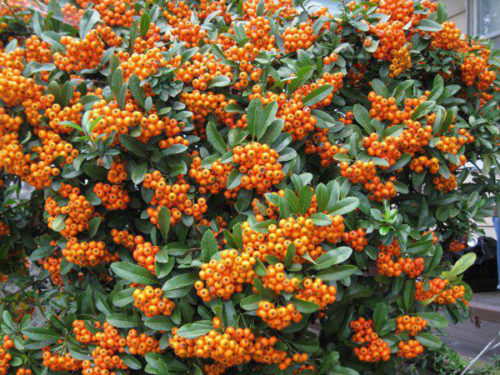



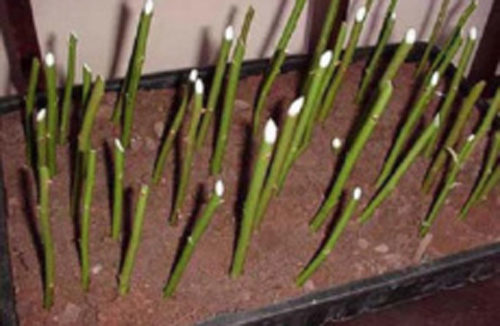
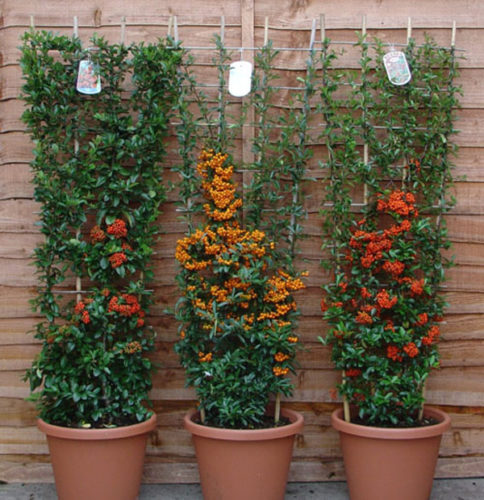
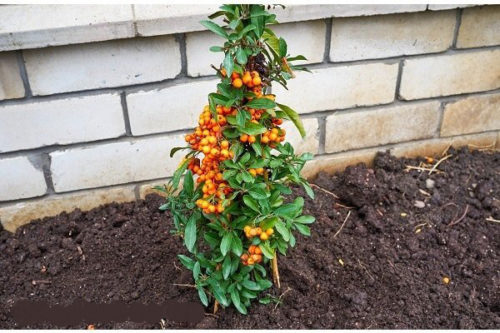
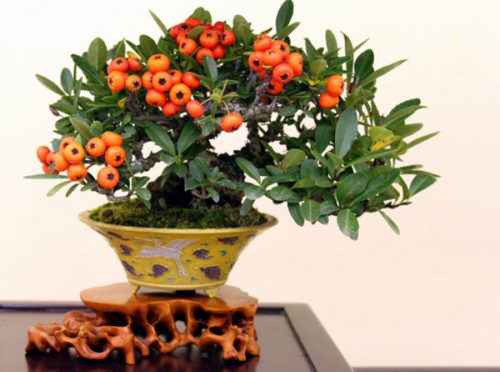

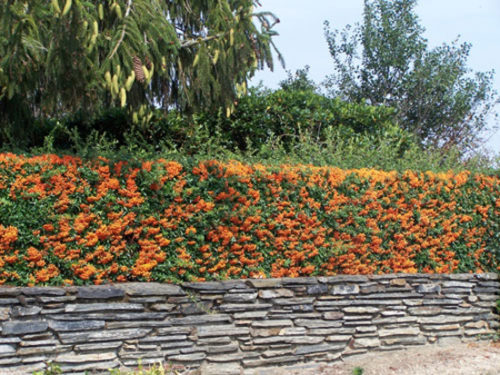

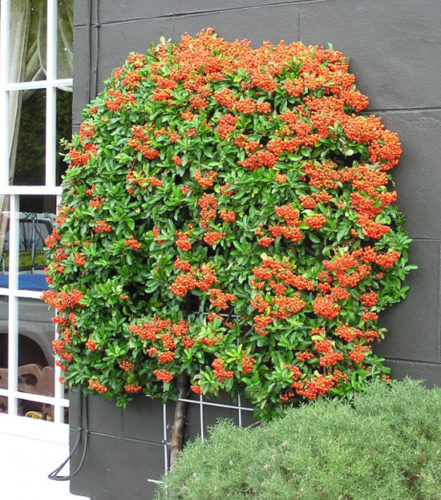
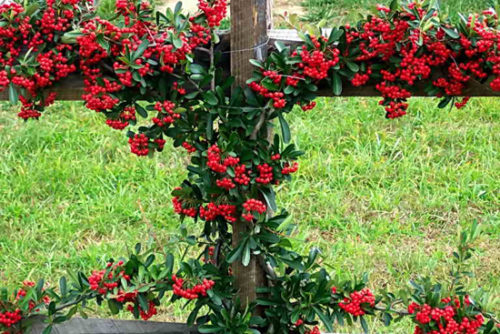
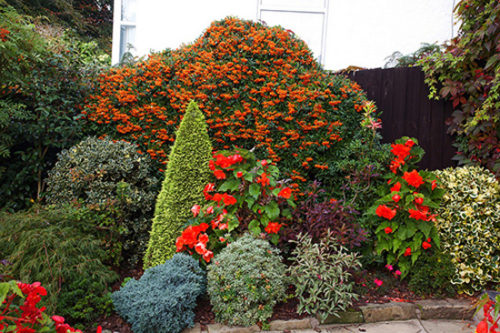












 Start a discussion ...
Start a discussion ...